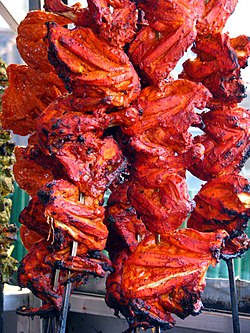 Chicken tandoori in Mumbai, India | |
| Alternative names | Chicken tandoori [1] [2] [3] [4] [5] [6] [7] [8] [9] |
|---|---|
| Course | Appetiser or main course |
| Region or state | Indian subcontinent [6] [7] [8] [10] [11] [12] |
| Associated cuisine | Indian, Pakistani, Punjabi cuisine |
| Main ingredients | Chicken, dahi (yogurt), honey, tandoori masala |
| Variations | Tandoori paneer, fish tandoori |
Tandoori chicken is a dish made from chicken marinated in yogurt and spices and roasted in a tandoor , a cylindrical clay oven. The dish is now popular worldwide. The modern form of the dish was popularised by the Moti Mahal restaurant in New Delhi, India in the late 1940s.







